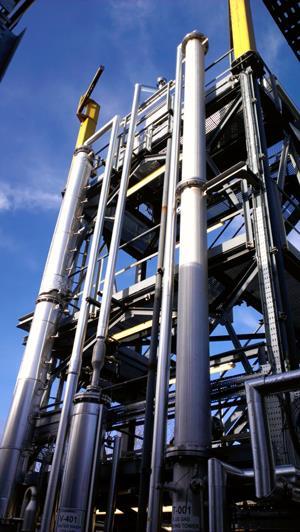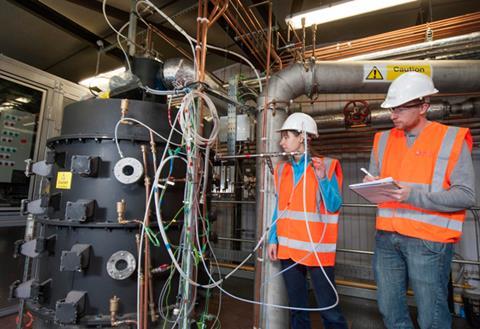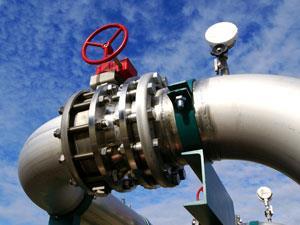Andy Extance finds uncertainty over efforts to capture and store CO2 from power generation
In a small and unremarkable industrial unit between Sheffield and Rotherham, researchers and technicians mill around three long metal cylinders. The cylinders are the latest absorber for the UK’s Pilot-scale Advanced CO2 Capture Technology (Pact) project. Within the absorber, CO2 produced by burning fuels will react with amine solvents like monoethanolamine (MEA), capturing it for later release in a desorber. Using MEA, Pact can absorb around a tonne of CO2 from burning coal, explains Kris Milkowski, the facility’s business development manager.
While Pact is at the heart of the UK’s carbon capture and storage (CCS) efforts to rein in emissions of CO2, the greenhouse gas fuelling climate change, its size reflects the technology’s status. Even if the site didn’t currently return the gas to the atmosphere, its impact on the estimated 40 billion tonnes emitted worldwide in 2014 would be imperceptible. But if such pilot plants can be scaled up, CCS could keep existing fossil-fuel power plants running while taming their climate threat.
Despite having been in use since the 1970s, CCS remains far from standard today. That’s illustrated by a set of instruments PACT bought from a carbon capture experiment at the nearby Ferrybridge coal-fired power plant that could absorb 100 tonnes of CO2 a day. Without further government funding or a business model to support continued operation, the completed experiment’s facilities were demolished in June 2014.
As well as economic and political issues, technical and chemical challenges contribute to the slow progress. Today, most carbon-capture processes rely on MEA and its energy-intensive absorption–desorption cycle, making them expensive, as well as bringing further pollution problems. Consequently scientists are considering many alternative absorber materials as well as approaches that avoid the absorption–desorption cycle altogether.
Catching the flue

By pumping ‘flue gas’ directly from various mini power plants through its absorber, Pact puts experimental carbon capture methods through realistic paces. ‘The gas is then fed up the absorber from the bottom, and the solvent is sprayed onto the packing material inside it from the top,’ Milkowski explains. Though the reaction mechanisms are not yet fully understood, MEA first captures CO2 through a zwitterionic acid–base interaction, and then by covalently forming a carbamate. To reverse this process and release CO2 in its desorber, PACT raises the solvent temperature to 118°C using a pressurised hot water heat exchanger.
A review of life cycle analyses of CCS’s overall environmental impact by Andrea Ramirez from Utrecht University in the Netherlands and colleagues shows why more efficient processes are needed.1 ‘In power plants with CCS, additional fossil fuels need to be extracted to produce the same amount of energy,’ Ramirez explains. ‘There is therefore an increase in emissions from mining, exploration and fuel transport.’ She points out that this is also a reason to clean up the fossil fuel supply chain.
MEA also degrades relatively easily on reaction with flue gas impurities. Not only is replacing it expensive, but some emitted byproducts, such as nitramines and nitrosamines, are toxic. Ramirez highlights that research into different, more stable amine solvents is therefore well underway, and that plant configurations that capture the toxic emissions are also being tested. This problem must be solved, but it’s not serious enough to condemn CCS completely, she adds. ‘We recognise the implications in other environmental categories, but using fossil fuels without CCS will have much larger consequences.’
Getting physical
Rather than tweaking 1970s technology, some researchers are bringing 21st century materials to CCS. Martin Schröder is working on metal–organic frameworks (MOFs) at the University of Nottingham in the UK. ‘These three-dimensional materials can be tuned by variation of organic linkers and metal nodes,’ he says. ‘The CO2 can interact with metal centres and/or the ligand functionalities. This is physisorbtion or chemisorption of CO2 into a MOF that shows permanent porosity. It’s a bit like making molecular gas cylinders.’

MOFs can potentially reduce energy consumption because they don’t require facilities to provide big temperature changes – known as ‘temperature swing’ units. Instead, like alcohol-based solvents such as Selexol used in some CCS configurations, MOFs exploit a ‘pressure swing’, capturing CO2 at high pressures and releasing it at low pressures.
Schröder’s team fills columns with its leading MOF, NOTT-300. When passing gas mixtures through this column, NOTT-300 binds CO2 and SO2 selectively.2 ‘We’re not making carbamates, we’re making supramolecular long-range contacts that hold CO2 within the pores,’ Schroder explains. ‘We’re looking at chemical recognition between the framework material and CO2 via hydrogen bonding.’
While NOTT-300 is a promising lead material, like many MOFs its high selectivity and high storage capacity are hampered by competition between CO2 and water in flue gas. ‘One possible way round this is making the material more hydrophobic, but this certainly hasn’t been solved,’ Schröder says. ‘Also, many MOFs are unstable to water and temperature.’ His team is also trying to scale up NOTT-300 production, something he underlines is vital for carbon capture. ‘You’re talking about vast CO2 quantities and you may only have a few milligrams of new material. The compound may work beautifully, but you might not be able to make enough, and it might be too expensive.’
These remain key problems, agrees Stefano Brandani from the University of Edinburgh, UK, even though MOFs have been studied for carbon capture for a decade. His group has investigated them since at least 2007 and is now collaborating with the Norwegian research organisation SINTEF to test 20–30g of pelletised MOFs. ‘I believe this project is the first to test the best MOFs for carbon capture at this scale,’ Brandani says. While MOFs are among several porous materials Edinburgh researchers are studying for carbon capture, they perform particularly well. ‘Absorption capacities at 0.1 bar and 40ÀC are double some commercial zeolites,’ says Brandani.
Brandani is leading a project called Adsorption Materials and Processes for Carbon Capture from Gas-Fired Power Plants (AMPGas), covering MOFs, amines coated onto mesoporous supports and novel zeolites. Solid sorbents are already used commercially, with Coca-Cola using them to capture and purify CO2 from burning natural gas for power and heat, releasing it to carbonate drinks. And now advanced solid sorbents are technically ready for even large scale tests, Brandani believes.
He highlights that US-based industrial gas supplier Air Products has installed two vacuum swing adsorption units exploiting nanoporous materials in a refinery in Port Arthur, Texas. Between startup in January 2013 and June 2014, the facility had already captured over a million tonnes of CO2 for sale for enhanced oil recovery in nearby fields. After displacing the oil, which can be sold for profit, the gas remains underground. ‘Clearly the cost of carbon capture can be offset if there is a market willing to pay for CO2,’ Brandani emphasises.

Beyond such ‘post-combustion capture’ methods, PACT is also looking at another way to get high purity CO2, known as oxyfuel combustion capture. Conventional flue gas from burning coal in air contains typically around 12% CO2, along with 80% nitrogen. Instead of pumping flue gas through an absorber to extract and concentrate CO2, oxyfuel schemes recycle a portion of the flue gas into the burner, along with pure oxygen. For coal, this can raise CO2 levels to 95%.
The CO2 concentration in flue gas from natural gas boilers is lower, up to just 9%, as combustion is much ‘leaner’, with more excess air. However research has shown oxyfuel can raise that above 80%. PACT is also exploring flue gas recycling in gas turbines to increase CO2 concentrations and enhance post-combustion capture.
Answering burning questions
In case carbon capture chemistry wasn’t already important enough, the stakes have recently been raised yet higher. Governments have agreed it would be dangerous to exceed a 2°C global temperature rise (from pre-industrial levels). To stay below that level, according to the UN Intergovernmental Panel on Climate Change’s latest report, CCS could be needed to help ‘suck’ CO2 from the air. Burning CO2 -consuming crops for energy and capturing and storing the resulting emissions is currently seen as the most plausible way of doing this.
Biomass is therefore a topic PACT is preparing to study in detail. ‘Biomass generates very different flue gas composition,’ Milkowski explains. ‘We have problems with halides inside the vessel and corrosion associated with that. Trace gases in biomass flue gas may impact solvent performance and degradation pathways. Biomass is also more difficult to filter than coal. It has finer particulates, and particulates might impact nitrosamine emissions from MEA.’
The systems compare well against renewable energy
However, PACT’s biomass studies have been delayed by great demand for the facility’s capabilities and upgrades to enhance its systems. The site was also hit by an unforeseen setback in coming online. ‘Unfortunately, metal thieves stole bits of our plant,’ Milkowski recalls. ‘We would have been operational by September 2012, but were delayed until August 2013.’
Milkowski echoes Brandani’s sentiments that capture technologies are ready for large-scale demonstrations. He comments that ‘there isn’t a clear winner’ between oxycoal and gas with post-combustion capture. However, two UK demonstration projects expected to become operational between 2016 and 2020 should clarify matters. An oxycoal project at the giant Drax power station near to PACT in Yorkshire, and a gas post-combustion facility in Peterhead, Scotland, will combine electricity generation, CO2 capture, transport and underground storage. ‘Generally the systems compare well against renewable energy, but it’s not until we operate that we can understand the real costs,’ Milkowski says.
Concrete proposition
As both a chemist and chemical engineer, the University of Sheffield’s Peter Styring thinks these approaches are too engineering-focused. He chairs the CO2Chem network, which wants to use CO2 as a chemical feedstock. ‘As a chemist I’ll dissolve CO2, reagent and a catalyst in solvent, before flooding the vessel with nitrogen to create an inert atmosphere,’ Styring stresses. ‘So I’ve just reversed what the chemical engineer’s done. If you’ve got CO2 and nitrogen, why strip out the nitrogen? We can miss out the conventional capture step, and go straight to utilisation.’
The energy needed to break up the minerals is significant
Following this philosophy, Styring’s team has made polymethyl acrylate, a kilogram of which consumes 1.01kg of CO2. Similar approaches can also be used in inorganic chemistry. To demonstrate, Styring holds up a caved-in transparent plastic bottle containing grey solid. A mixture of Portland cement and water has reacted with CO2 in the sealed bottle, reducing the pressure inside so the atmosphere crushed it. The rough-and-ready experiment originated from CO2Chem member Colin Hills, of the University of Greenwich, UK, who co-founded a company called Carbon8 to commercialise such mineralisation processes.
Utilisation efforts do have drawbacks, notes Brandani, with mineralisation potentially needing large amounts of silicates to be mined, and which must be available as fine particles to react quickly enough. ‘The energy needed to break up the minerals is significant and the scale is much larger than a carbon capture plant,’ he asserts. ‘In regions such as Europe one would also need to consider the cost and public acceptance issues linked to large-scale quarrying and transport.’
But Hills has identified numerous waste mineral sources that could be used to make concrete from CO2, such as slag from steel production. ‘You’re locking up CO2 and because you’re making it from waste you’re getting a more environmentally friendly product,’ stresses Katy Armstrong, the network manager for CO2Chem, also from the University of Sheffield. For similar reasons, Styring’s team is investigating producing carbon-negative urea from atmospheric nitrogen, captured CO2 and hydrogen generated by electrolysing water. They are considering siting a pilot facility next to PACT, getting its nitrogen and CO2 directly from its flue gas.
CO2 means business
Sustainably creating useful products can be a convincing factor in the difficult debate over carbon capture. According to the Global CCS institute, the total capacity of CCS projects across the world is currently 40 million tonnes of CO2 per year.3 By contrast, in 2013 utilisation projects were already consuming 200 million tonnes of CO2 per year.4
‘We’d never say CO2 utilisation is going to solve the global warming problem,’ Armstrong admits. ‘But companies like Carbon8 are finding economic and lower carbon routes to market. There are lots of approaches that together would make a difference to emissions. They’re all part of a huge cake that we’re going to have to take lots of slices out of.’
We want an energy system that provides clean, reliable and affordable electricity
Recognising that post-combustion carbon capture is still the best choice in some cases, Styring’s team is also hunting new absorbers. The scientists have developed ionic liquids that can be used in pressure-swing systems, potentially lowering costs by avoiding heating. One promising candidate5 is a polymerised ionic liquid that can absorb 77% of its own weight of CO2 with a selectivity over nitrogen of 70:1. But the cost is currently extremely high, around £15 million per tonne, compared to £940 per tonne for MEA. Consequently, the Sheffield group is continuing to investigate how best to balance technical and economic considerations.
Thanks to such efforts, progress is being made on tackling MEA’s energy and stability problems. ‘In 10 or 15 years some of these solutions will be applied,’ Ramirez says. ‘But – and this is the largest issue – this will only happen if demonstration projects are built.’
Currently, that’s not entirely certain. The Global CCS Institute is tentatively optimistic, noting in November 2014 that 22 projects were in construction, up 50% from 2011. Yet the number of projects it is monitoring has fallen from 75 in 2012 to 55 in 2014. Existing operational plants have survived, with the attrition largely hitting projects in the planning stages. This trend continued in February 2015, when the US government cancelled development of FutureGen 2.0, considered the country’s most comprehensive CCS project yet. $200 million (£130 million) had already been spent on it.
Nevertheless, research continues in the hope that political and economic stumbling blocks will be overcome, and in the knowledge of how vital success is. ‘We want an energy system that provides clean, reliable and affordable electricity,’ stresses Ramirez. ‘Because they play a key role in securing reliability and affordability fossil fuels will still be in the world’s electricity mix for decades. However, we should not accept using fossil fuels without CCS.’
Andy Extance is a science writer based in Exeter, UK
References
1 M Corsten et al, Int. J. Greenhouse Gas Control, 2013, 13, 59 (DOI: 10.1016/j.ijggc.2012.12.003)
2 S Yang et al, Nat. Chem., 2012, 4, 887 (DOI: 10.1038/nchem.1457)
3 The global status of CCS: 2014 summary seport, Global CCS Institute http://bit.ly/carbonreport
4 M Aresta et al, J. CO2 Util., 2013, 3–4, 65 (DOI: 10.1016/j.jcou.2013.08.001)
5 S Supasitmongkol and P Styring, Energy Environ. Sci., 2010, 3, 1961 (DOI: 10.1039/c0ee00293c)













No comments yet